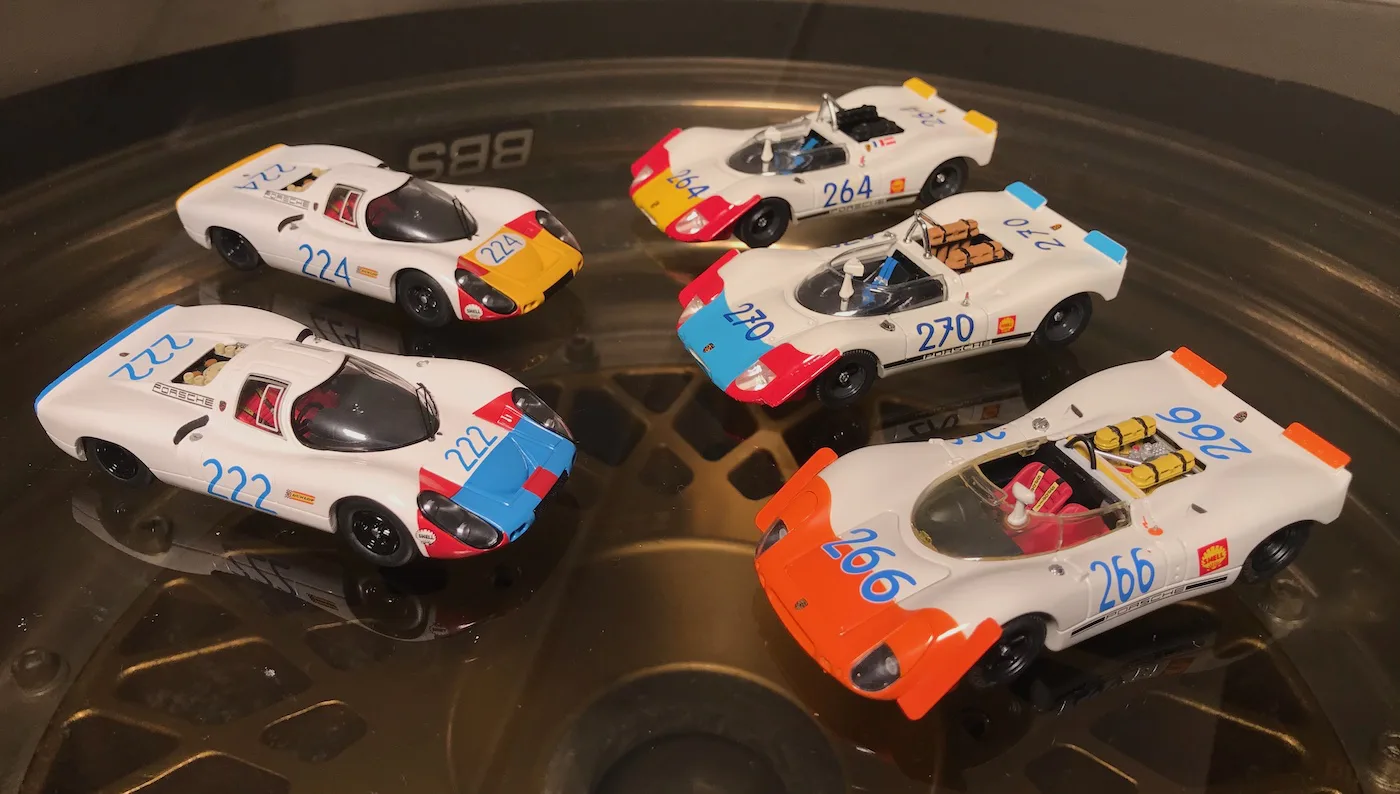Published May 15, 2024 | Last update November 3, 2024 | 25 models online
As Porsche only had small capacity road and racing cars in the 1950s and 1960s, they scored many wins in their classes, and occasionally also overall victories against bigger cars, most notably in the Targa Florio. The factory cars in the early years were often grey but between 1967 and 1969, Porsche System entered mainly white cars with distinctive colors on the front. With the introduction of the 3-liter category, Porsche’s chances grew, but they had to wait for the big 917 to win their first Le Mans 24h.
Porsche 907
1967 Le Mans 24h, Porsche 907 LH. The Porsche 907 was a light sportscar developed for endurance racing. With its small frontal surface and long tail it reached 300 km/h despite its small 6-cylinder engine. The debut was at the 24 hour race of Le Mans; the #40 retired with a broken camshaft while the other finished 5th overall and took class victory.
#40 Jochen Rind (A) / Gerhard Mitter (D) – DNF
Porsche 907 LH – 2.0 liter Porsche 901 flat-6, approx. 220 hp. Dunlop tires. Weight 620 kg. Aluminum space frame, chassisnr. 907 #003
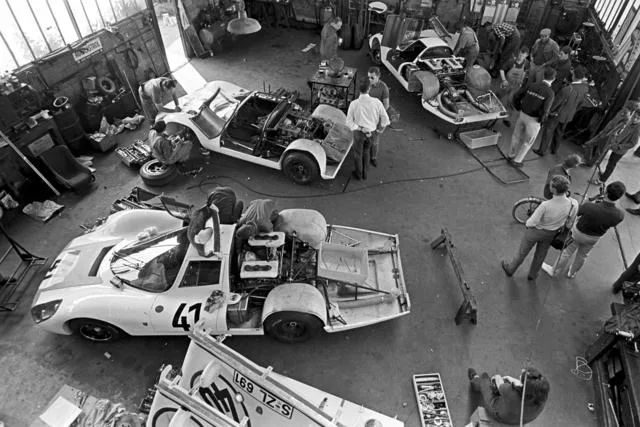
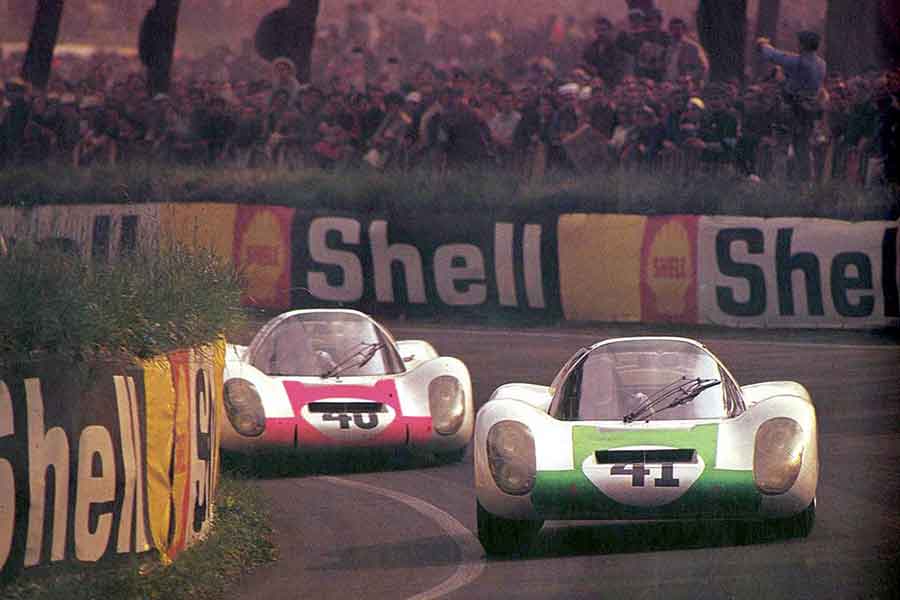
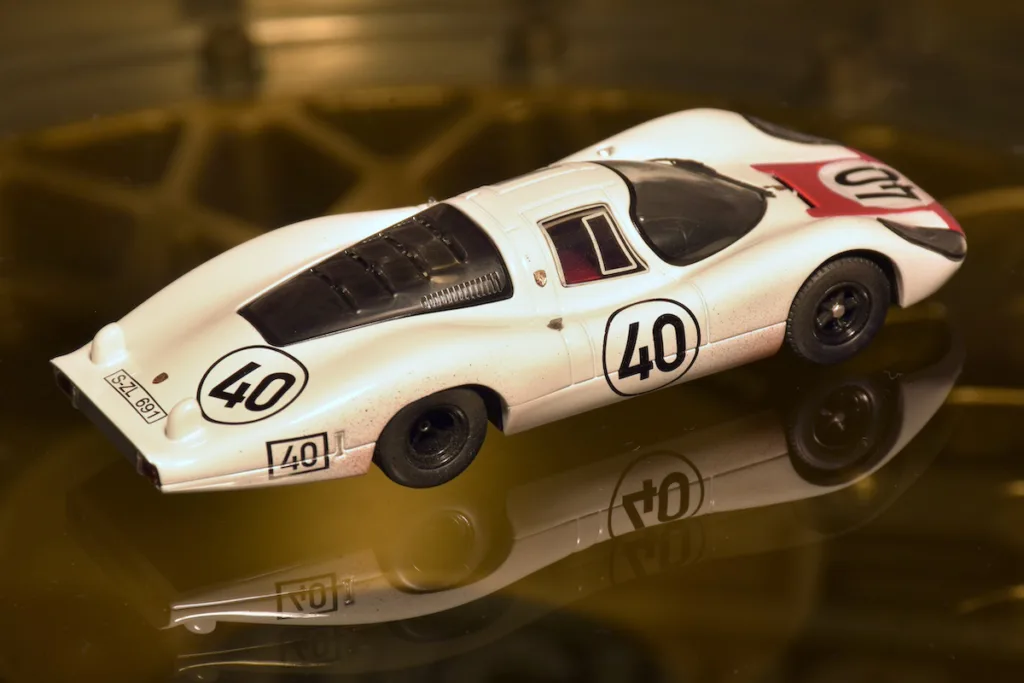
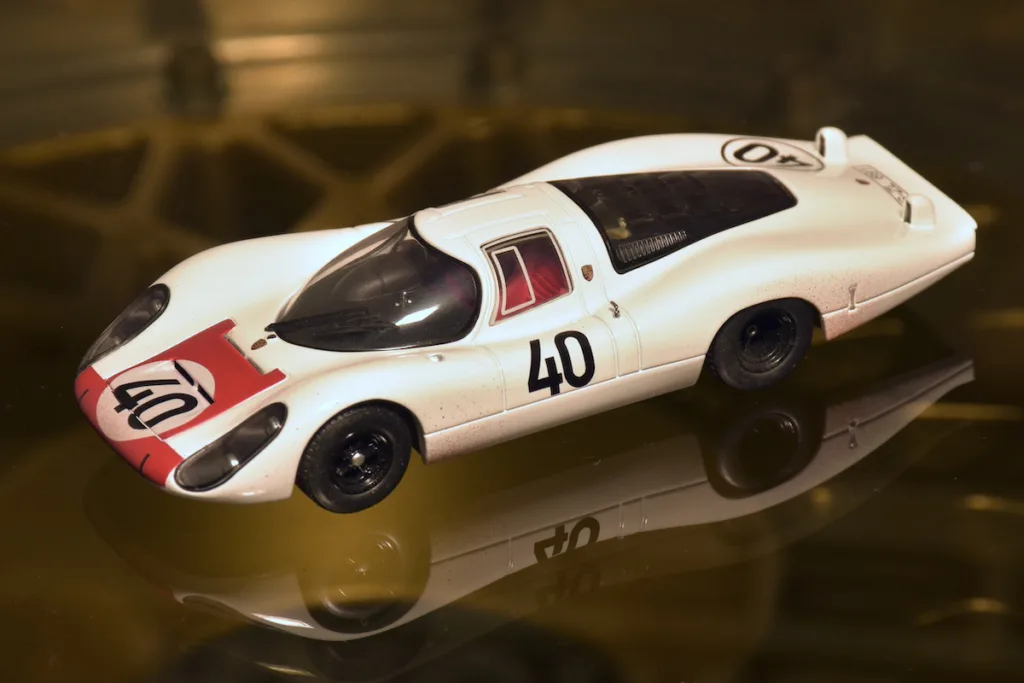
- SCHUCO 45 036 2500 limited 300 pcs. (diecast)
1968 Daytona 24h, Porsche 907 LH. For the 1968 season, the 907 was equipped with a 8-cylinder 2.2 liter engine. In Daytona 1968 the small Porsche scored a triple victory, just as Ferrari did a year earlier. But the Ferrari’s had twice the engine size and horsepower, but did less laps. A month later, the little Porsches would also win Sebring.
#54 Vic Elford (GB) / Jochen Neerpasch (
D) / Rolf Stommelen (D)
| Jo Siffert (CH) – 1st
Porsche 907 LH – 2.2 liter Porsche 771/1 flat-8, approx. 270 hp. Dunlop tires. Weight 630 kg. Aluminum space frame, chassisnr. 907 #005
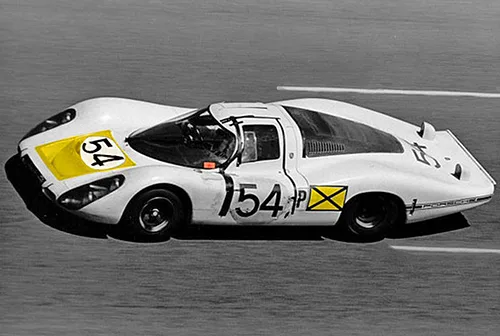
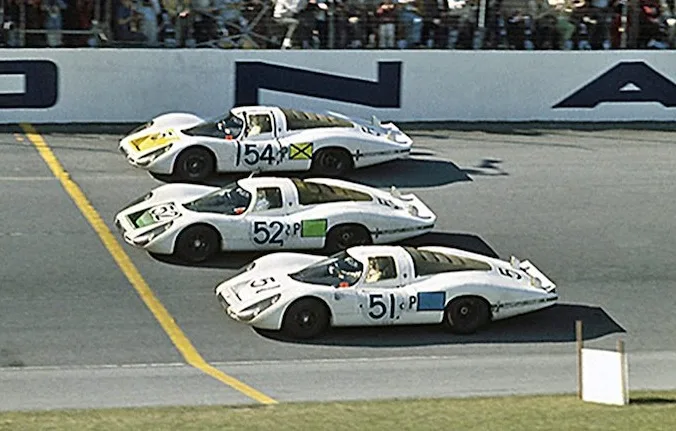
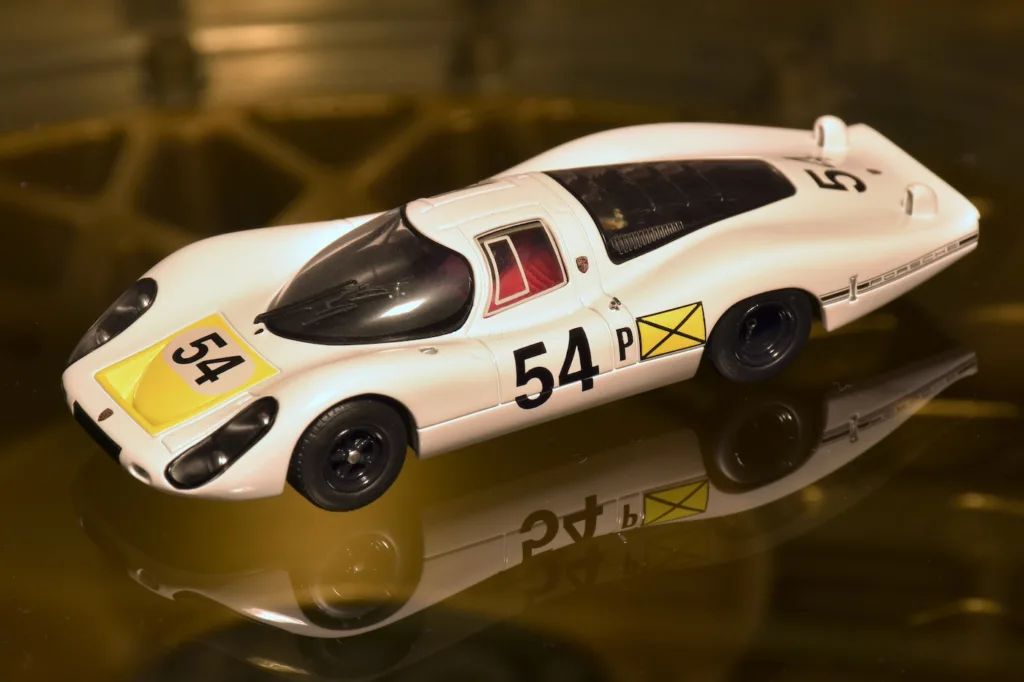
- SCHUCO 45 036 2900 limited 1.000 pcs. (diecast)
1968 Targa Florio, Porsche 907 KH. The short tail version of the Porsche 907 won the 1968 Targa Florio. The #224 won and the #222 finished 4th. The other places in the top 6 were all for Alfa Romeo 33.
#222 Hans Herrmann (D) / Jochen Neerpasch (D) – 4th
#224 Vic Elford (GB) / Umberto Magllioli (
I) – 1st
Porsche 907 KH – 2.2 liter Porsche 771/1 flat-8, approx. 270 hp. Dunlop tires. Weight 630 kg. Aluminum space frame, chassisnr. 907 #030 & #025
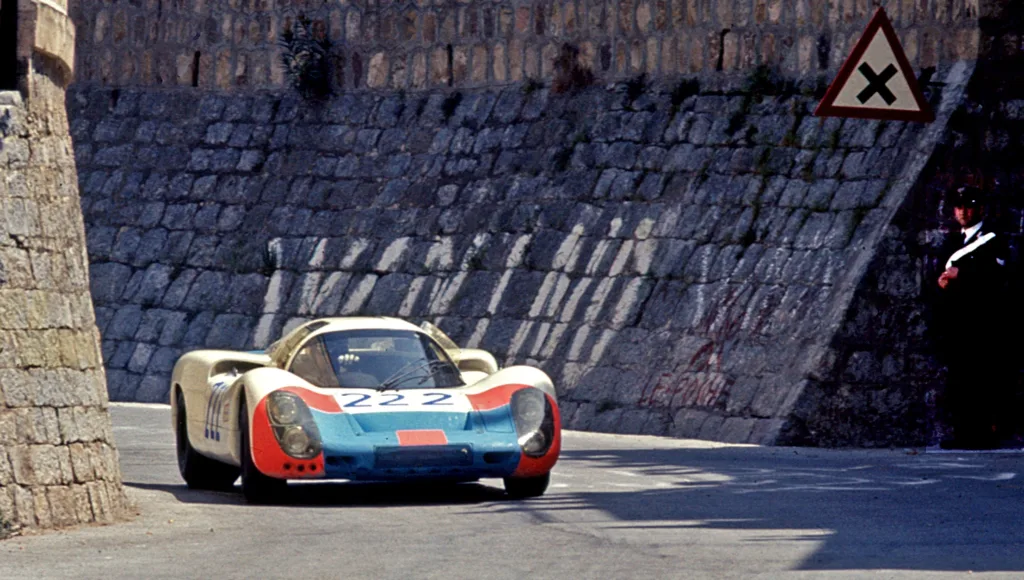
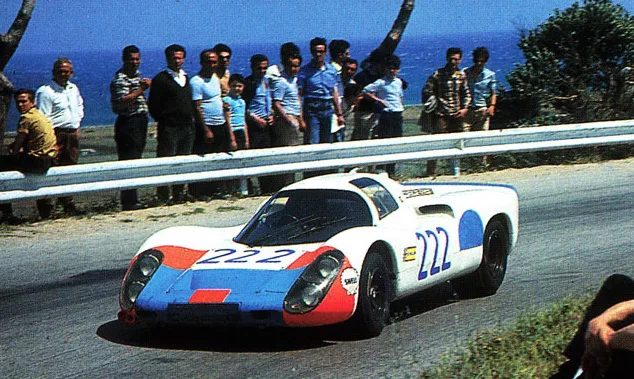
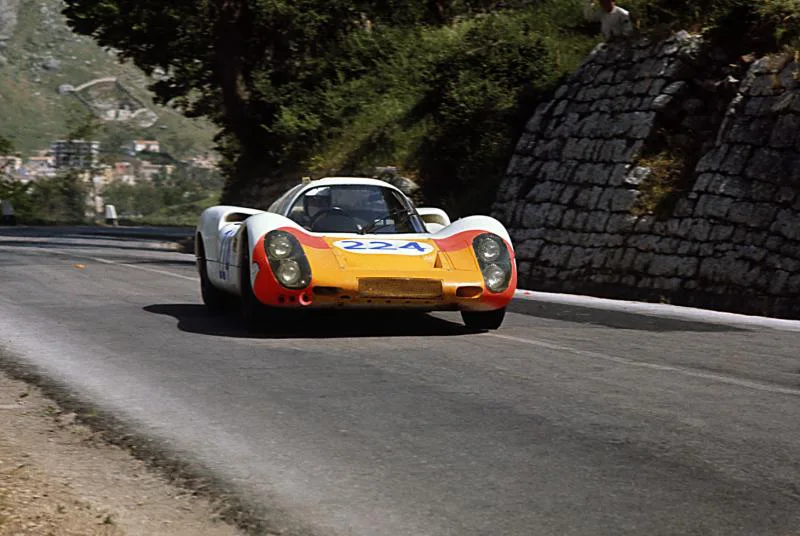
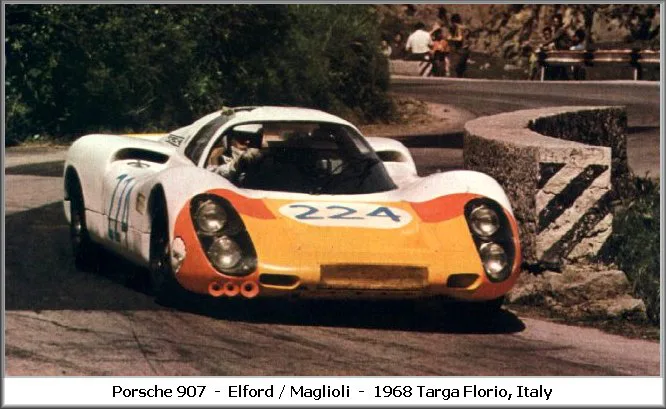
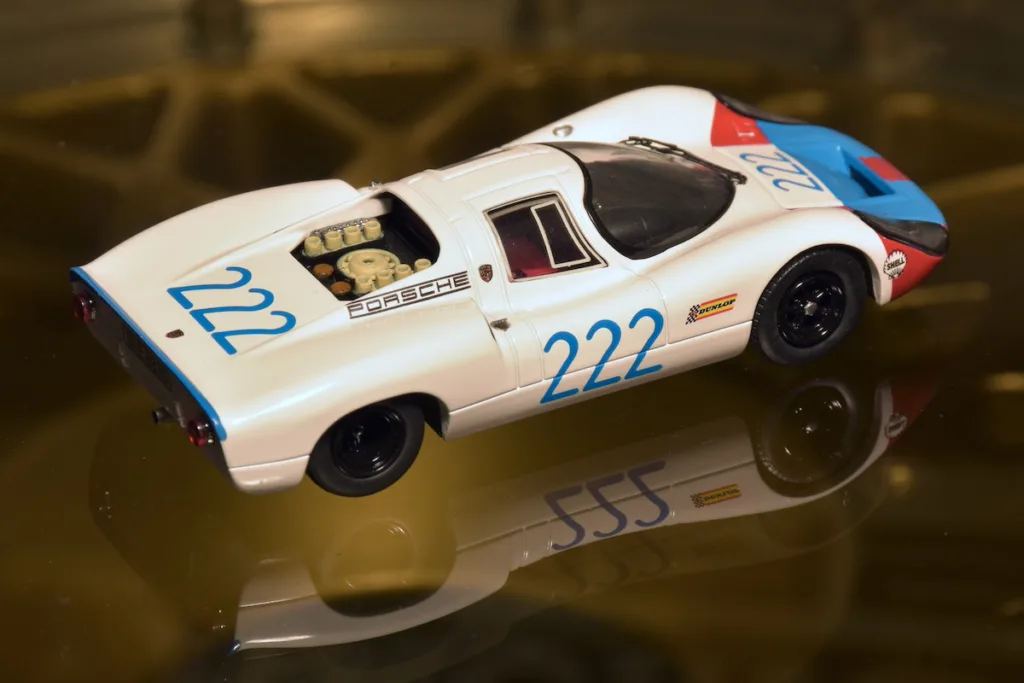
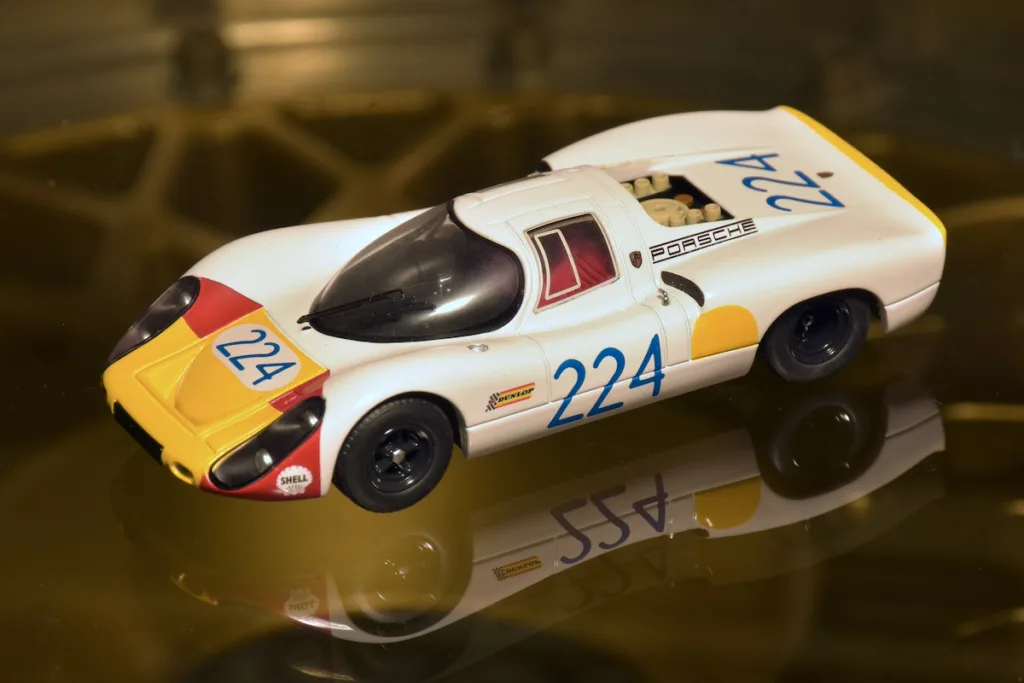
- SCHUCO 45 036 2200 limited 1.000 pcs. & 45 036 2100 limited 1.000 pcs. (diecast)
1968 Le Mans 24h, Porsche 907 LH. In Daytona 1968 the small Porsches scored a triple victory, but at Le Mans it should have no chance against the GT40 and the new 8-cylinder Porsche 908’s. But because all but one new factory 908’s failed and also some Fords retired, this privately entered 907LH took 2nd place overall and first in class.
#66 Rico Steinemann (CH) / Dieter Spoery (CH) – 2nd / 1st prototype < 3 liter
Hart Ski Porsche 907 LH – 2.2 liter Porsche 771/1 flat-8, approx. 270 hp. Dunlop tires. Weight 630 kg. Aluminum space frame, chassisnr. 907 #008
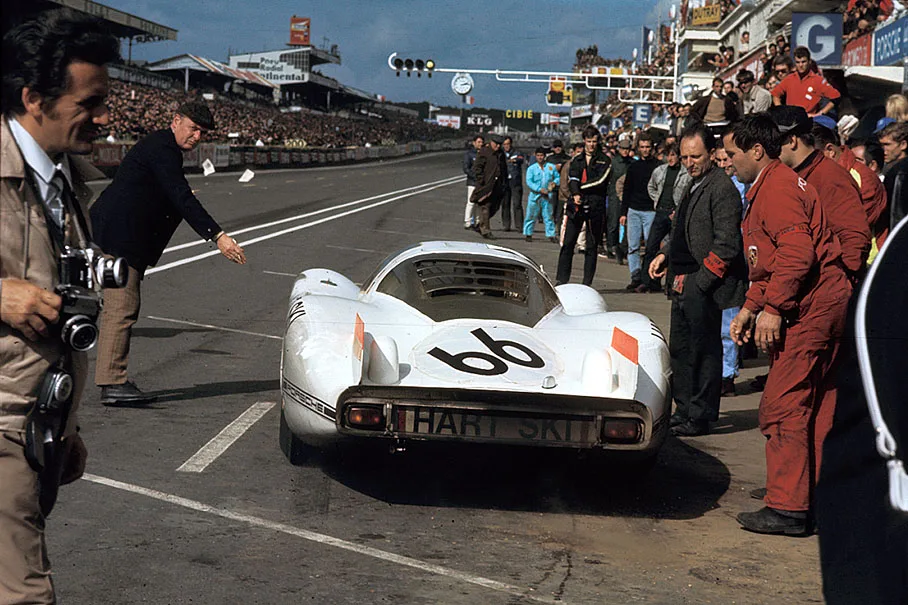
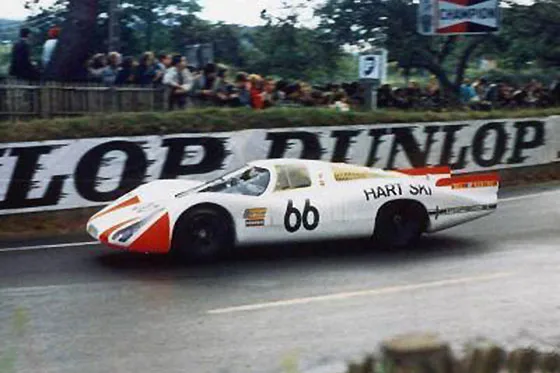
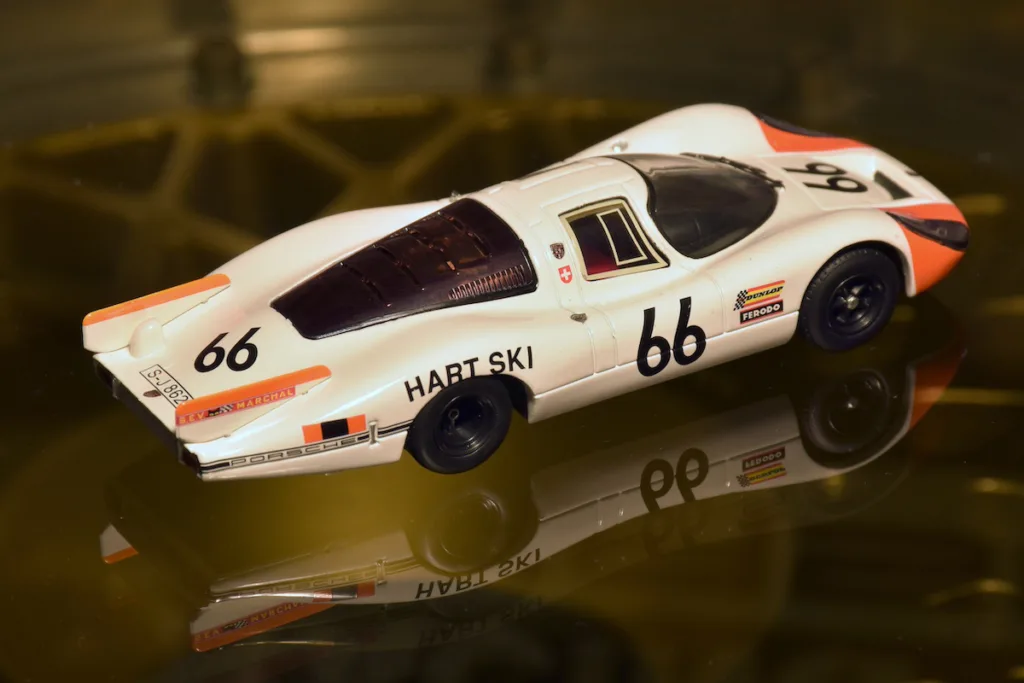
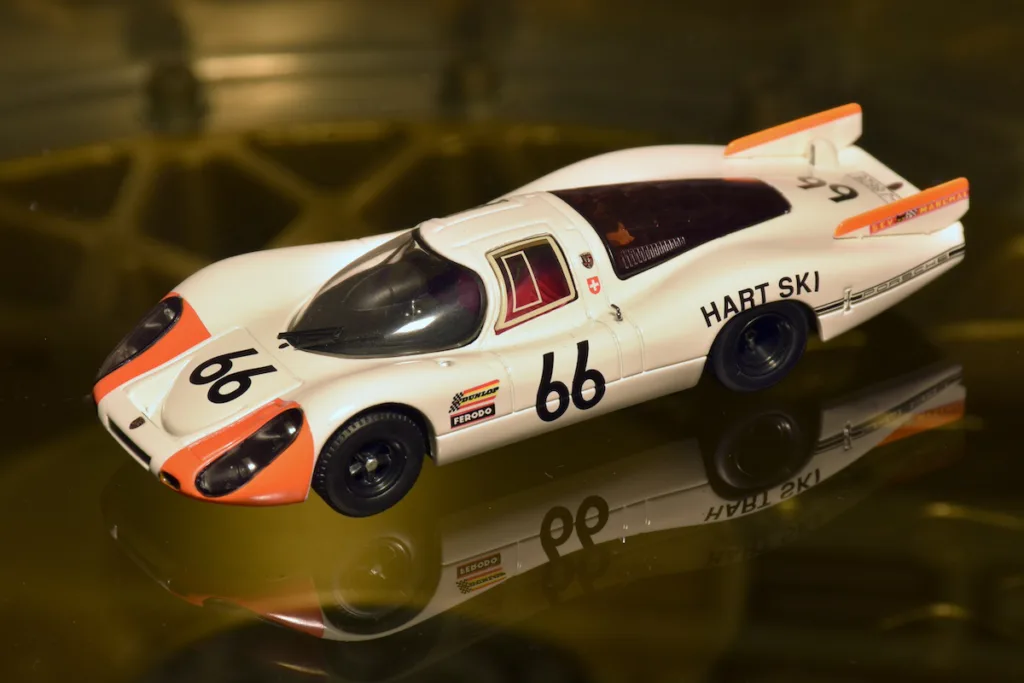
- SCHUCO 45 036 2800 limited 1.000 pcs. (diecast)
1968 – Porsche 908
1968 Nürburgring 1000 km, Porsche 908 KH. The Nürburgring 1000 km was the first world championship race that Porsche System entered the all new 908 with 3.0 liter 8-cylinder engine. It was an immediate success; #1 retired in the first lap, but the #2 car won the race in front of a factory 907 2.2 liter. Another 907 finished 4th.
#1 Gerhard Mitter (D) / Ludovico Scarfiotti (I) – DNF
#2 Jo Siffert (CH) / Vic Elford (GB) – 1st
Porsche 908 KH – 3.0 liter Porsche 908 flat-8, approx. 350 hp. Dunlop tires. Weight 600 kg. Aluminum space frame, chassisnr. 908 #009 & #008

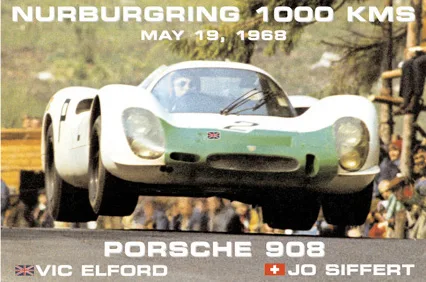
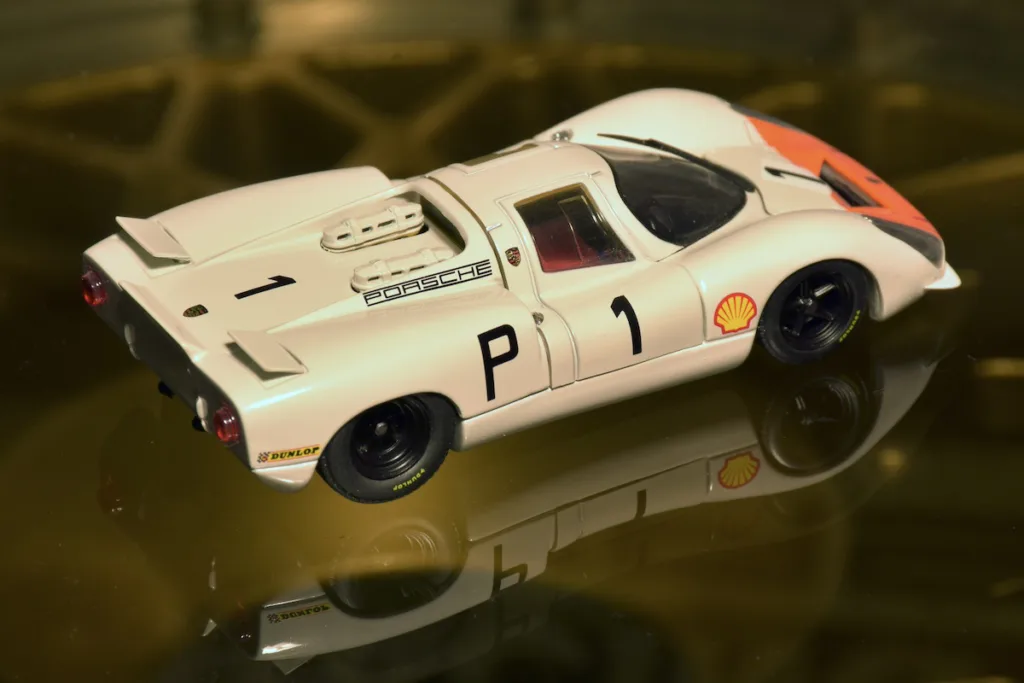
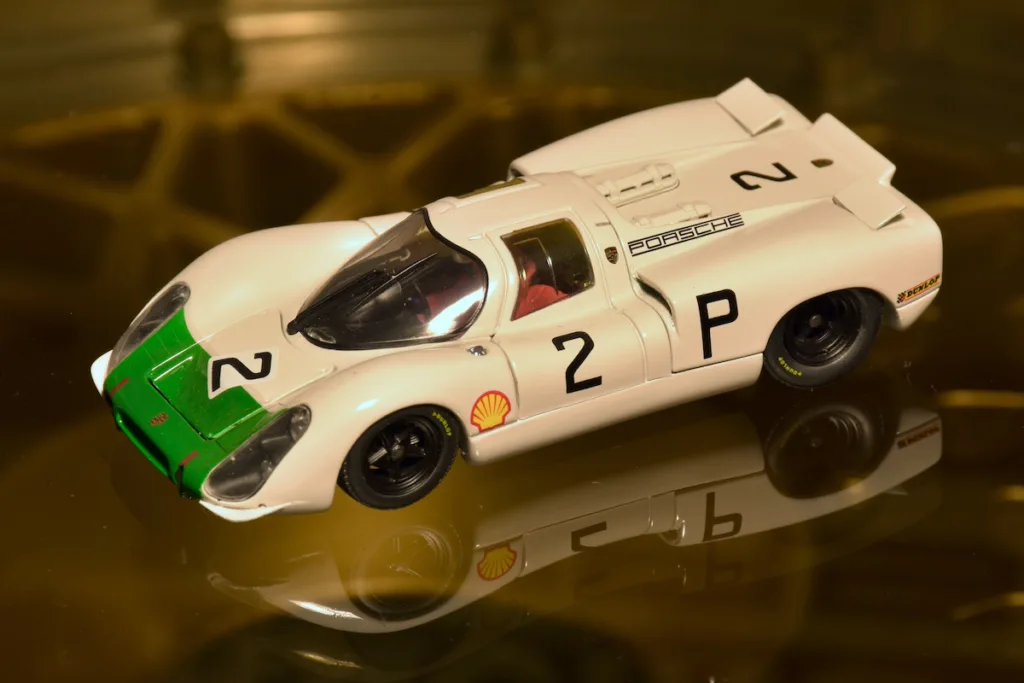
- EBBRO 43738 & 43739 (diecast)
1968 Spa 1000 km, Porsche 908 KH. Only one week after its successful debut at the Nürburgring, the 908 had to race in the rain at Spa. Jacky Ickx won in a Ford GT40 in front of one of the Porsche 907’s. The #6 908 crashed halfway the race and the #5 had to settle for third.
#5 Rolf Stommelen (D) / Hans Herrmann (D) – 3rd
Porsche 908 KH – 3.0 liter Porsche 908 flat-8, approx. 350 hp. Dunlop tires. Weight 600 kg. Aluminum space frame, chassisnr. 908 #011
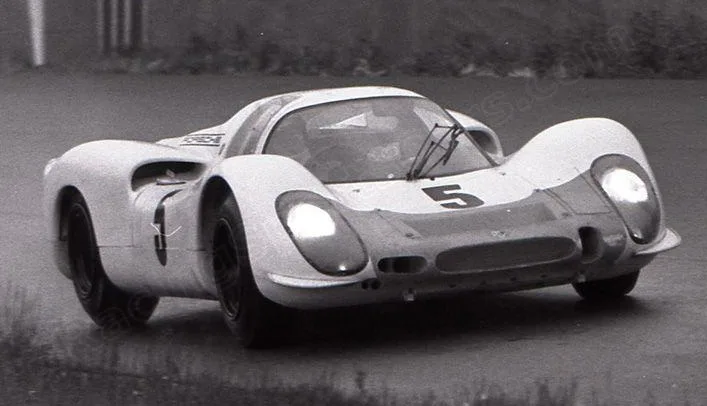
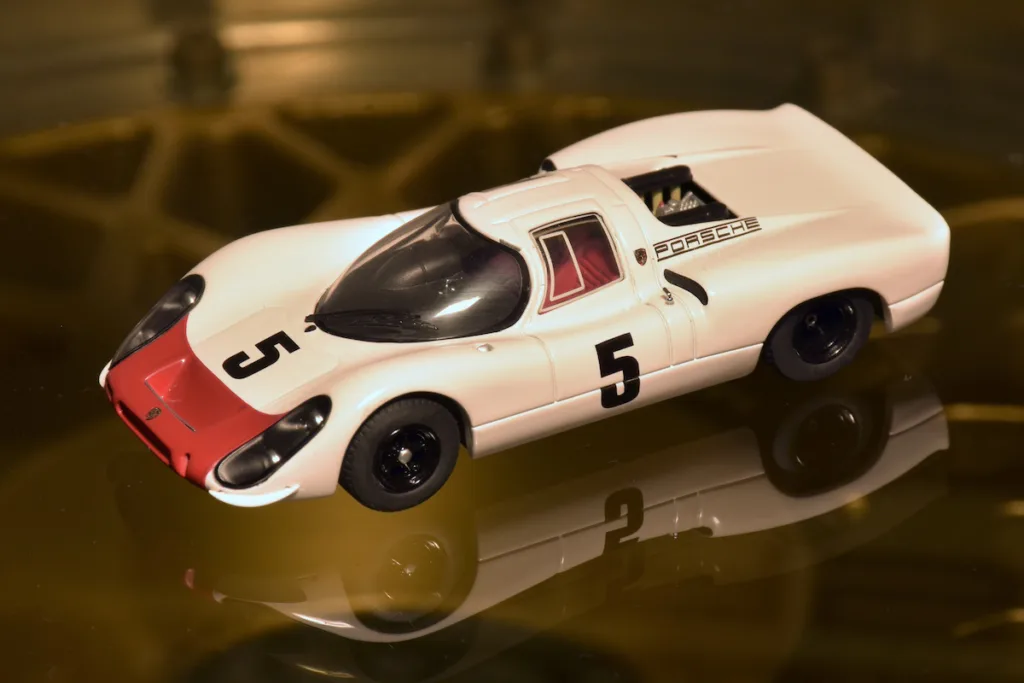
- SCHUCO 45 037 2500 limited 1.000 pcs. (diecast)
1968 Le Mans 24h, Porsche 908 LH. At Le Mans, Porsche launched a large scale assault with no less than four factory 908 long tails. It was fast, the cars were 1st, 2nd, 3rd and 7th in qualfying. Unfortunately the 908 was not yet as reliable as it would be in the following years. Two of the four cars retired with technical problems, one got disqualified. The one that made it to the finish was defeated by the Gulf Ford and the Scuderia Tartaruga Porsche 907.
#31 Jo Siffert (CH) / Hans Herrmann (D) – DNF / clutch
#32 Vic Elford (GB) / Gerhard Mitter (D) – DSQ / illegal alternator change
#33 Rolf Stommelen (D) / Jochen Neerpasch (
D) – 3rd / 2nd prototype
#34 Joe Buzzetta (USA) / Scooter Patrick (USA) – DNF / alternator
Porsche 908 LH – 3.0 liter Porsche 908 flat-8, approx. 350 hp. Dunlop tires. Weight 650 kg. Aluminum space frame, chassisnr. 908 #015, #016, #013 & #014

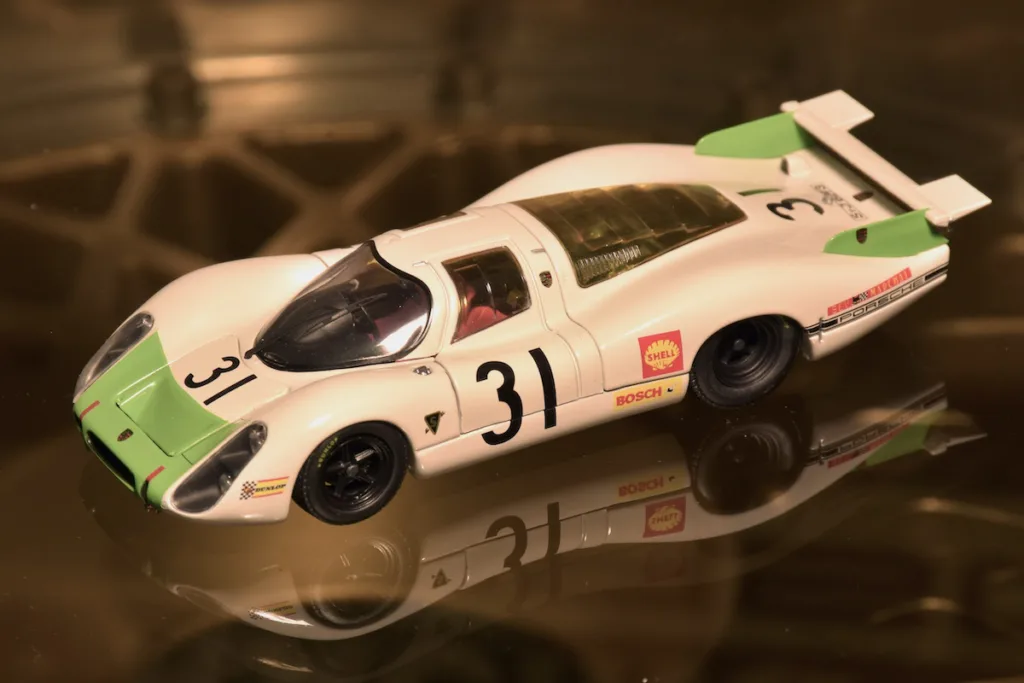
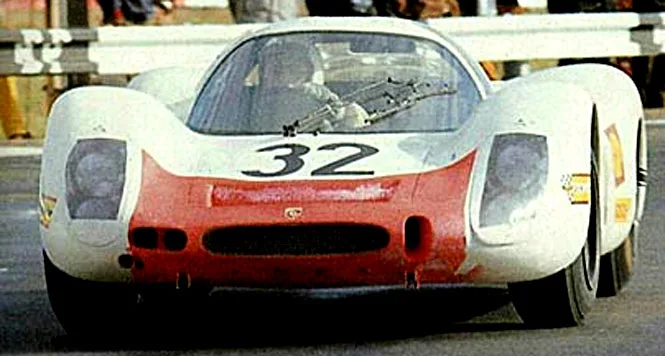

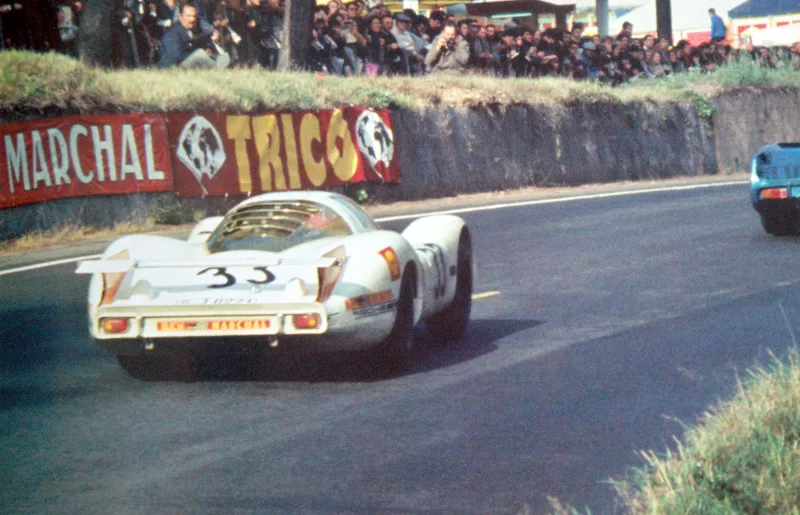


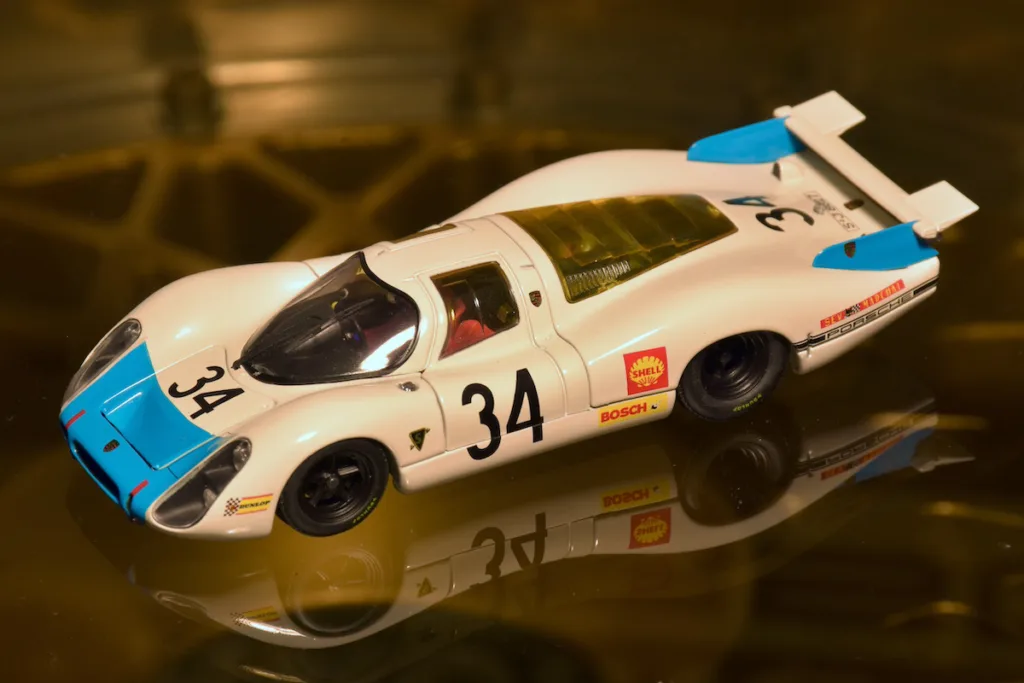
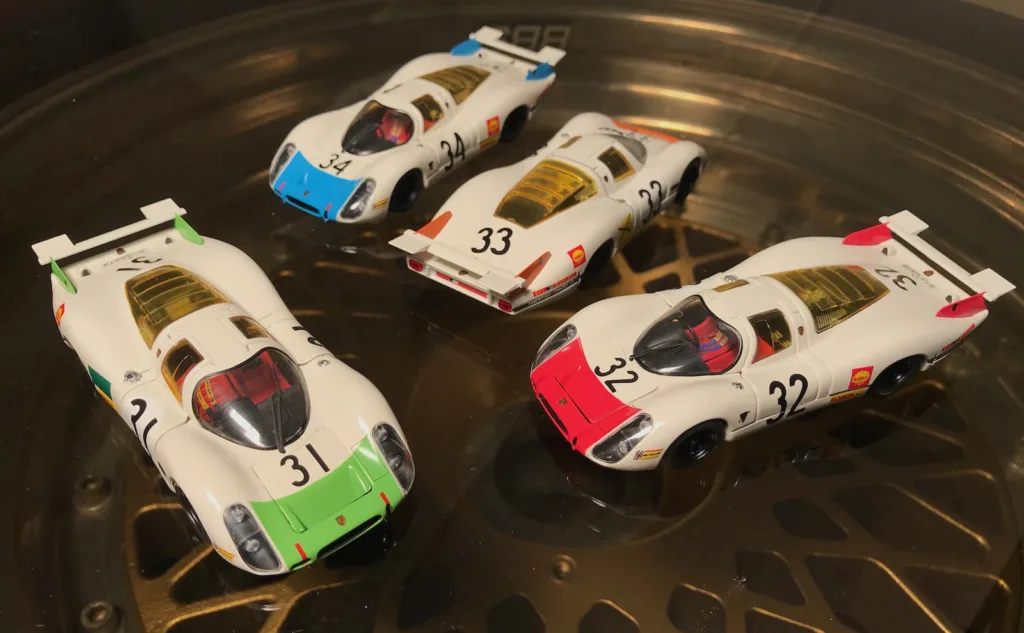
- EBBRO 44288, 44289, 44290 & 44291 (diecast)
1968 Montlhéry 1000 km, Porsche 908 LH. Reliability was an issue at Le Mans, but only 2 weeks later, two 908 LH’s destroyed the competition in the 1000km of Paris at the fast track of Monthléry.
#12 Rolf Stommelen / Hans Herrmann – 1st
Porsche 908 LH – 3.0 liter Porsche 908 flat-8, approx. 350 hp. Dunlop tires. Weight 650 kg. Aluminum space frame, chassisnr. 908 #015
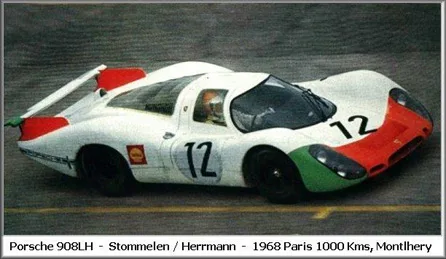
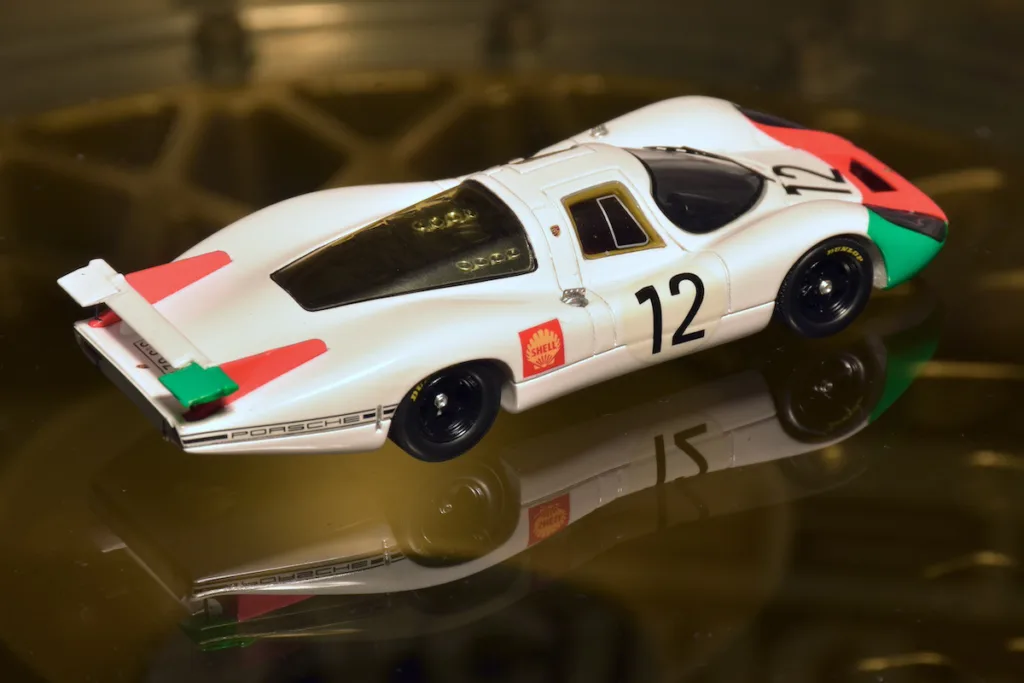
- SPARK SF050 (resin)
Porsche 909 Bergspyder
1968 Mont Ventoux hillclimb, Porsche 909 Bergspyder. In the 60’s hillclimbs were serious business. Porsche develop this car specially for it. The 909 Bergspyder was ultra light, weighing only 385 kg (approx. 850 lbs), with a 16 liter fuel tank, plastic body work and small brakes. Only two of these dangerous cars were built, but it developed into the successful 908/03. Rolf Stommelen risked his life at the Mont Ventoux in 1968 finishing 2nd behind team mate Gerhard Mitter in the #1.
#2 Rolf Stommelen (D) – 2nd
Porsche 909 Bergspyder – 3.0 liter Porsche 908 flat-8, approx. 350 hp. Dunlop tires. Weight 385 kg. Aluminum space frame, chassisnr. 909 #002
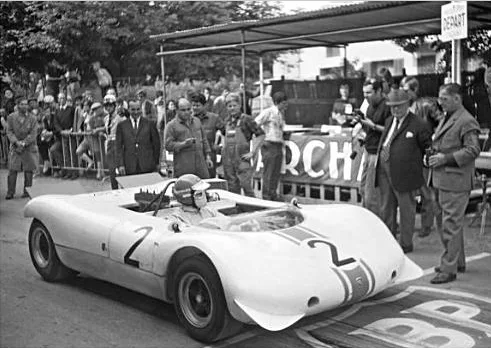

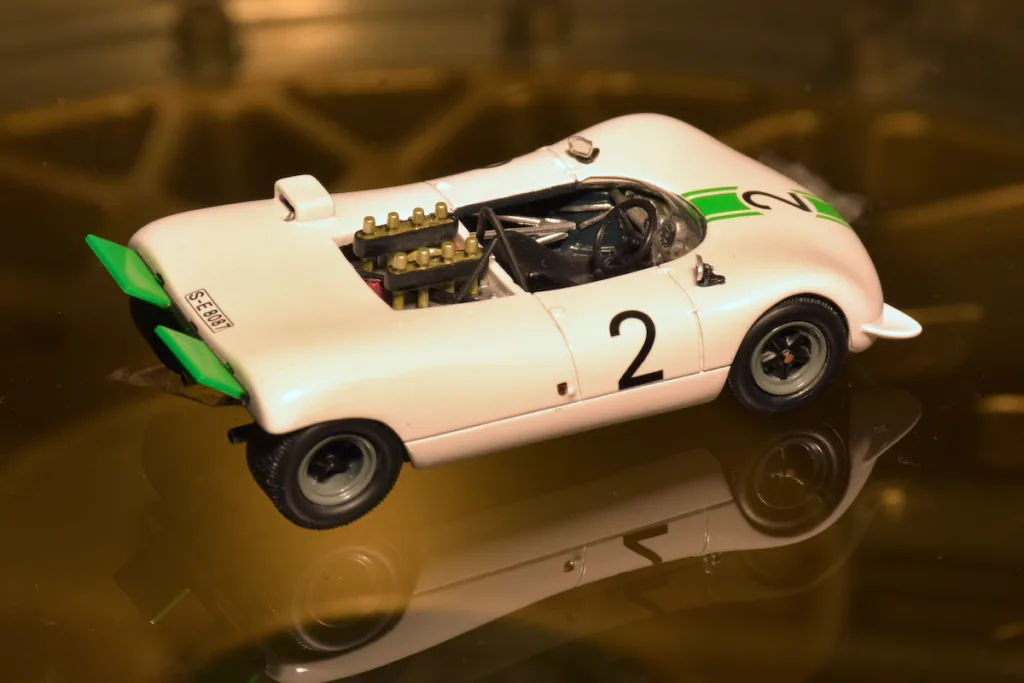
- PROVENCE PM0051 (resin)
1969 – Porsche 908
1969 Brands Hatch 1000 km, Porsche 908/02. Porsche introduced the open version of the 908, the 908/02 “Flunder” which was lighter than the closed 908 KH that was used in 1968. Also on the fast and difficult track of Brands Hatch it was a winner, when in the hands of a pair of extraordinary drivers such as Redman and Siffert.
#53 Brian Redman (GB) / Rolf Stommelen (D) – 1st
Porsche 908/02 “Flunder” – 3.0 liter Porsche 908 flat-8, approx. 350 hp. Dunlop tires. Weight 600 kg. Aluminum space frame, chassisnr. 908 #011

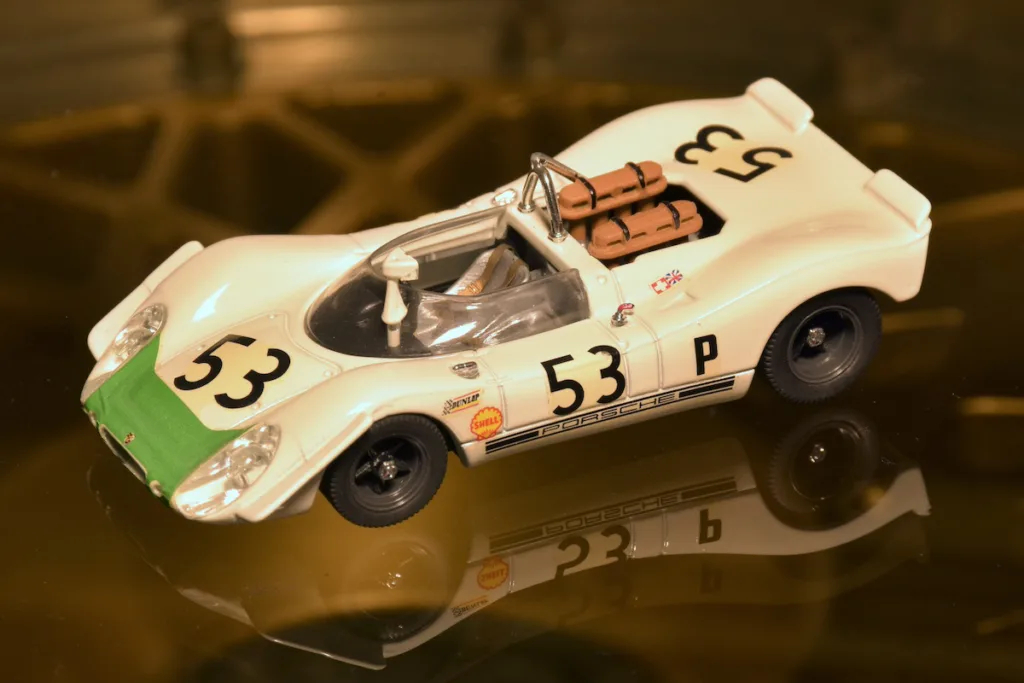
- BEST 9042 (diecast)
Porsches were quite dominant in the following races. At Monza the Porsche 908/02 filled the first 5 places, at the Nürburgring they were 1st and 2nd and also the Spa 1000 km was won by a 908/02. The next race in the world championship was the notorious Targa Florio.
1968 Targa Florio, Porsche 908/02. The Porsche 908 was the king of the Targa Florio, the works Porsches finished in the first four places. 908’s would also win the event in 1970 and 1971.
#264 Gérard Larrousse (F) / Rudi Lins (
A) – 21st
#266 Gerhard Mitter (D) / Udo Schütz (
D) – 1st
#270 Vic Elford (GB) / Umberto Maglioli (I) – 2nd
Porsche 908/02 “Flunder” – 3.0 liter Porsche 908 flat-8, approx. 350 hp. Dunlop tires. Weight 600 kg. Aluminum space frame, chassisnr. 908 #010, #014 & #013
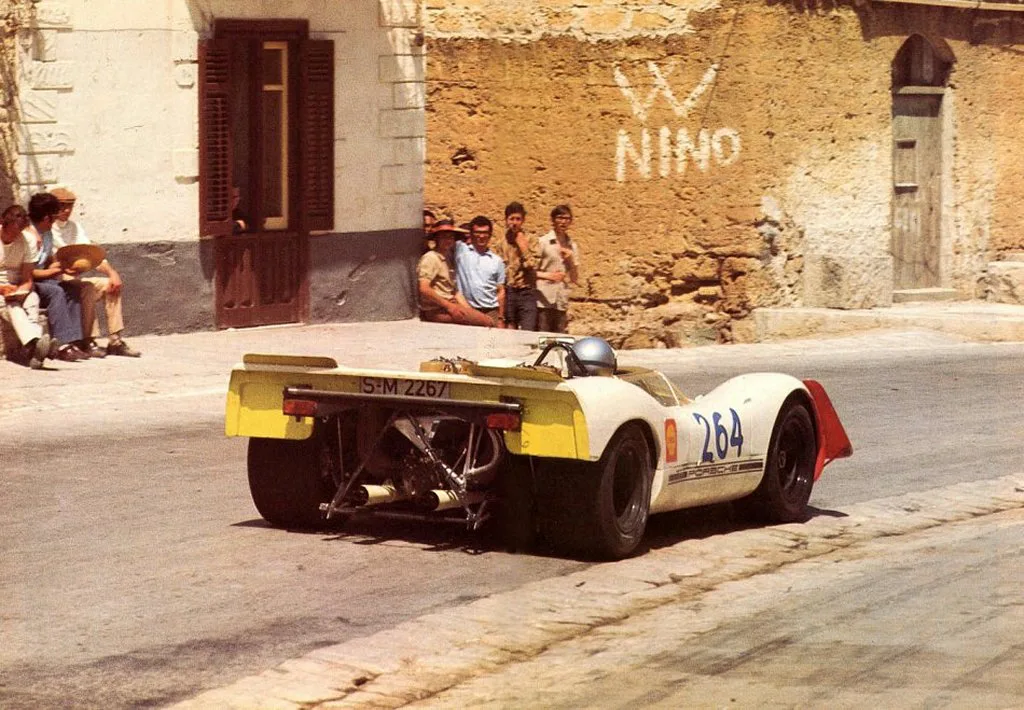

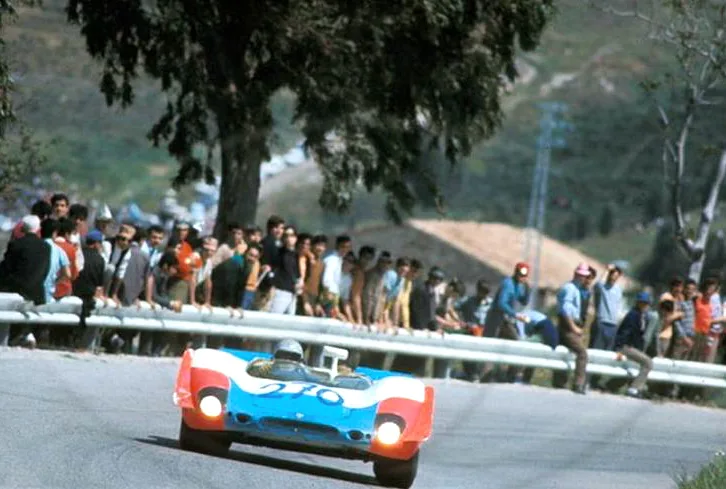
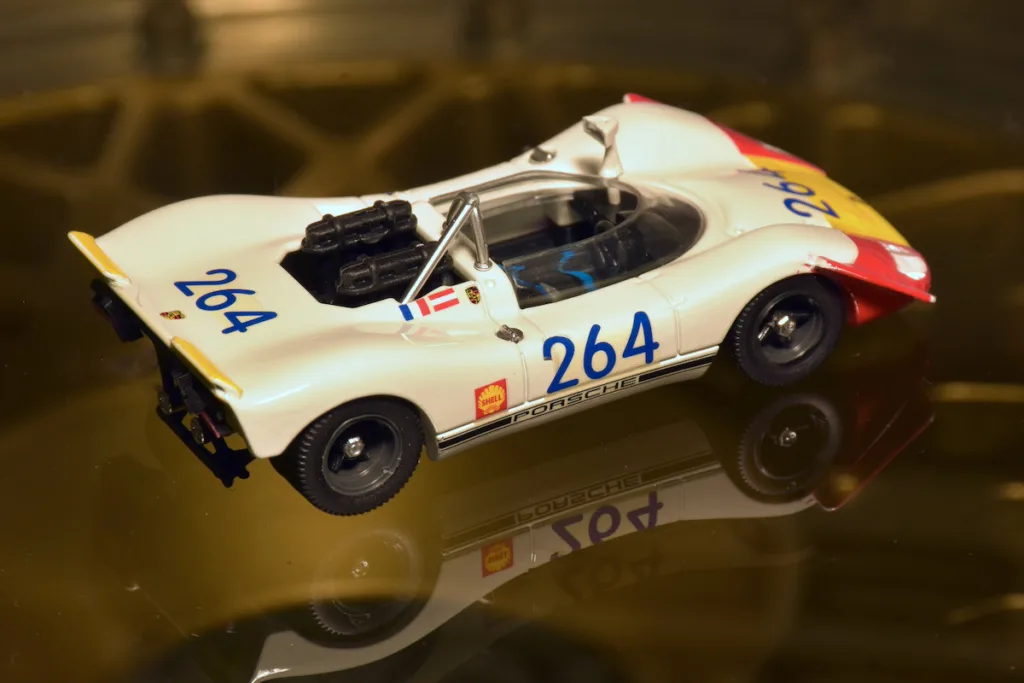
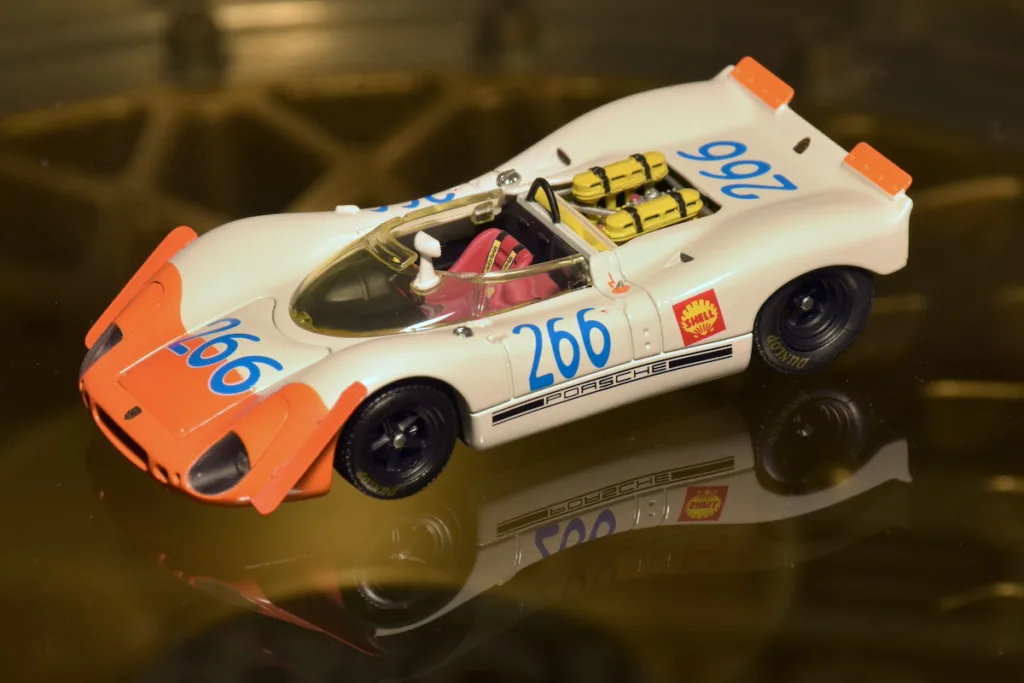
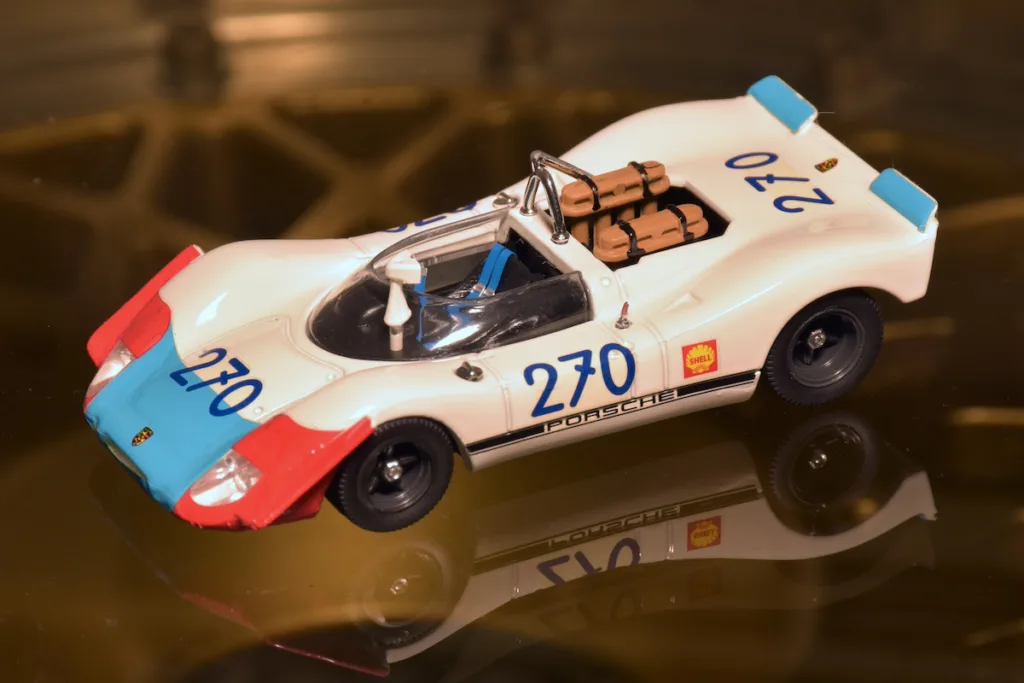
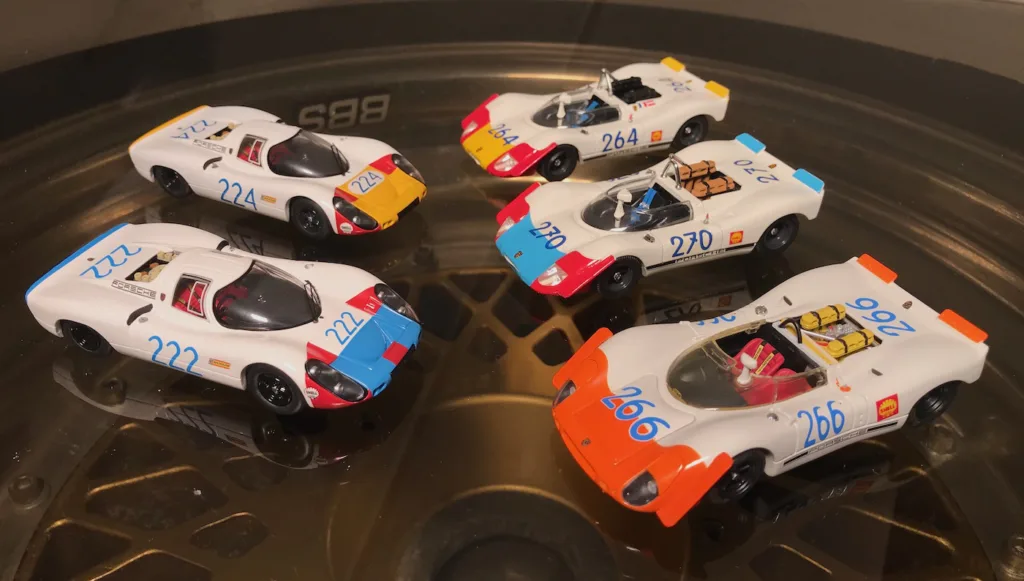
- BEST 9209 (diecast)
- EBBRO 43729 (diecast)
- BEST 9238 (diecast)
1969 Le Mans 24h, Porsche 908 LH. The #64 Porsche 908 LH chased Jacky Ickx’s Ford GT40 to the finish in Le Mans 1969. It just came 100 meter short and still Porsche was chasing its first Le Mans victory. The two other works Porsche 908’s retired with a broken gearbox and one crashed. But these weren’t the only factory Porsches present; also the spectacular 917 was present …
#23 Udo Schütz (D) / Gerhard Mitter (D) – DNF
#64 Gérard Larrousse (F) / Hans Hermann (D) – 2nd
Porsche 908 LH – 3.0 liter Porsche 908 flat-8, approx. 350 hp. Dunlop tires. Weight 650 kg. Aluminum space frame, chassisnr. 908 #030 & #031
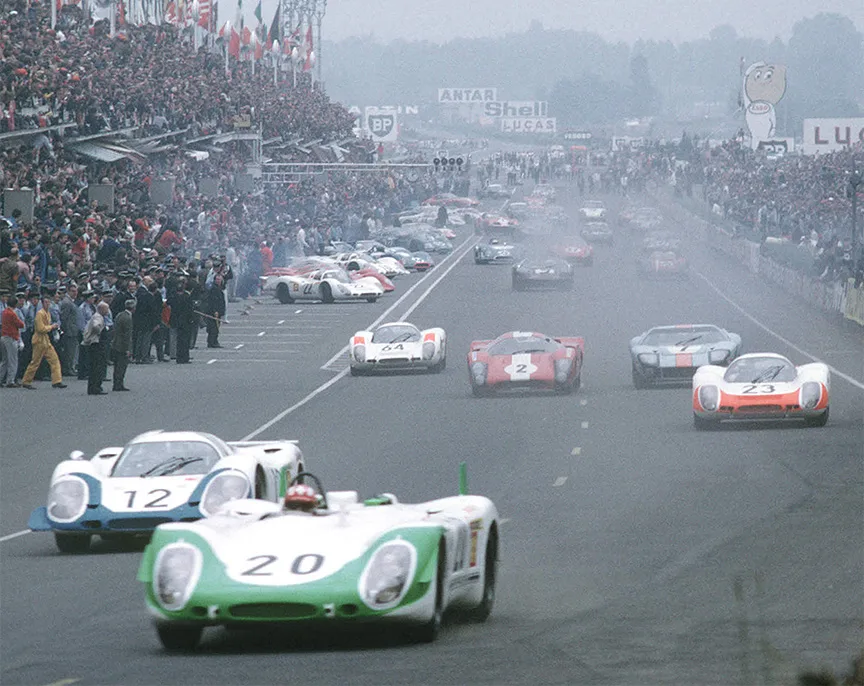
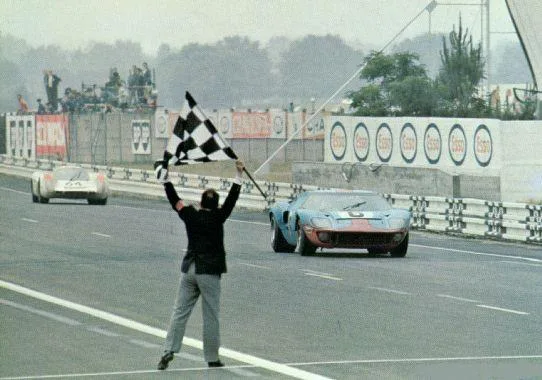
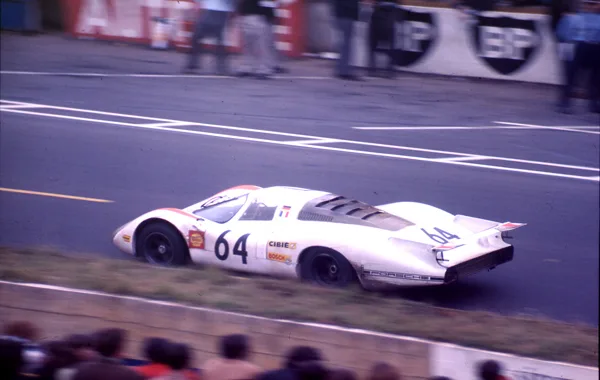
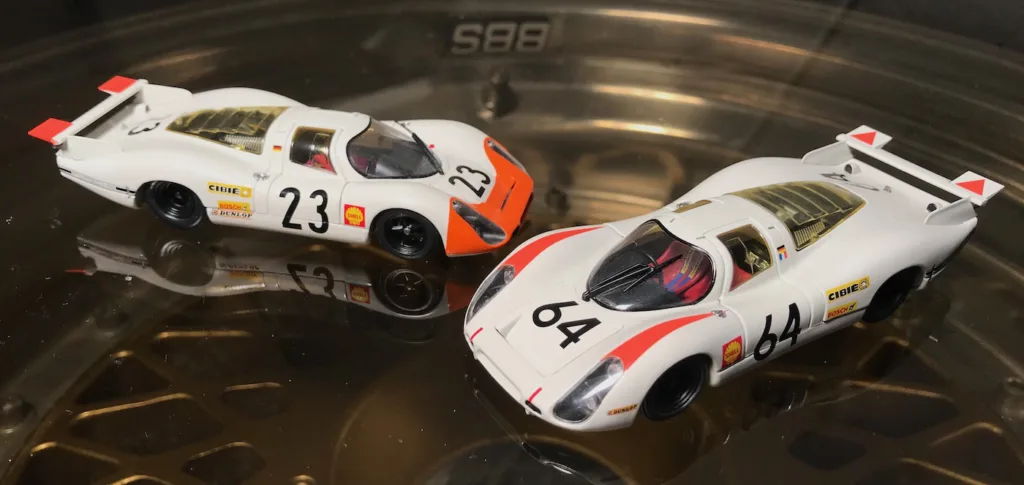
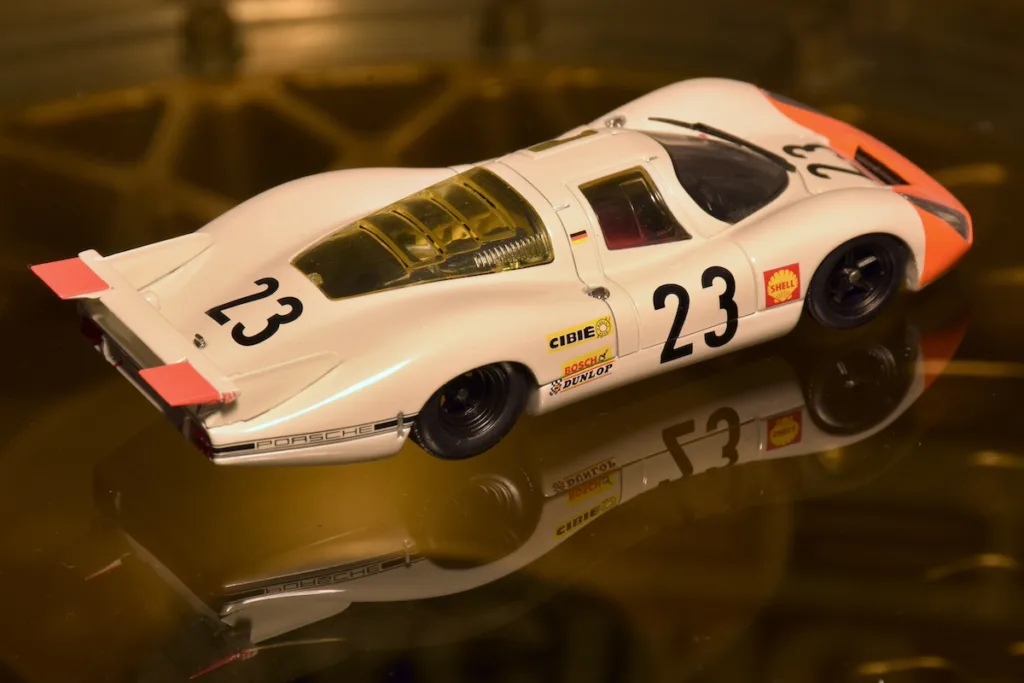

- | EBBRO 43741 & 43740 (diecast)
1969 – Porsche 917
1969 homologation, Porsche 917. Porsche built 25 cars of their 917 to get it homologated for group 5 sportscars. The first cars were difficult to drive, but after some aerodynamic adjustments they ruled endurance and sprintraces in 1970 and 1971. After another change of rules, the Porsche 917would continue its domination but now in Interserie and CanAm.
917 homologation car
Porsche 917L – 4.5 liter Porsche 912.00 – V12 180º, approx 570 hp. Dunlop tires. Weight 810 kg. Aluminum space frame, chassisnr. 917 #001
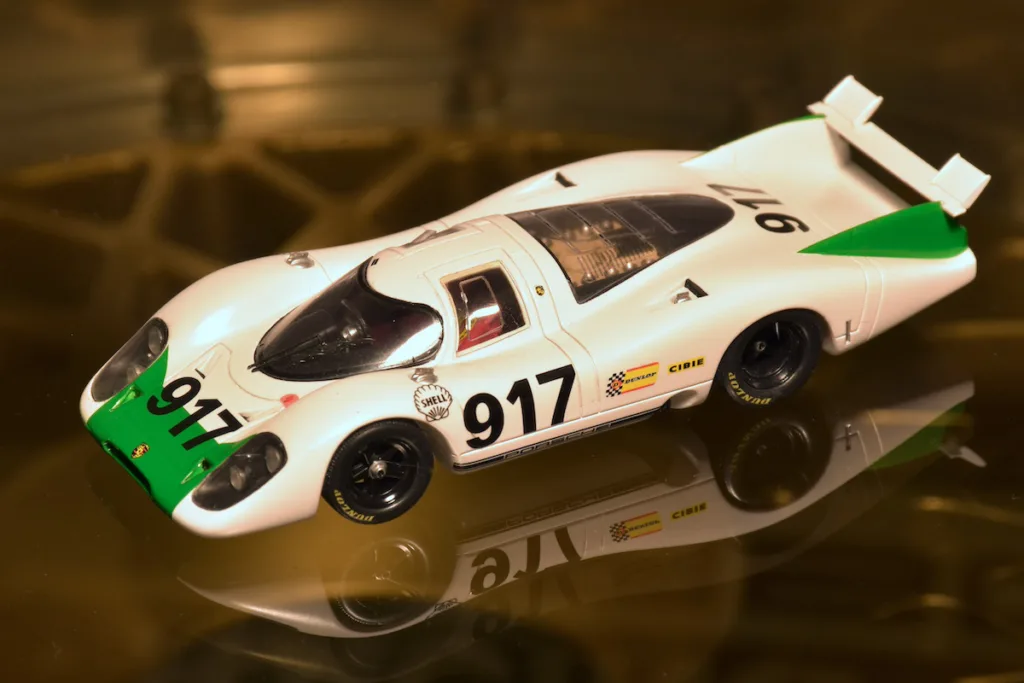
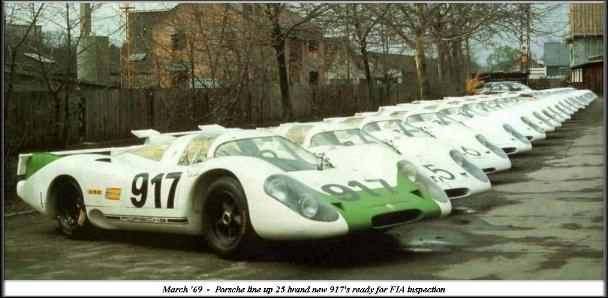
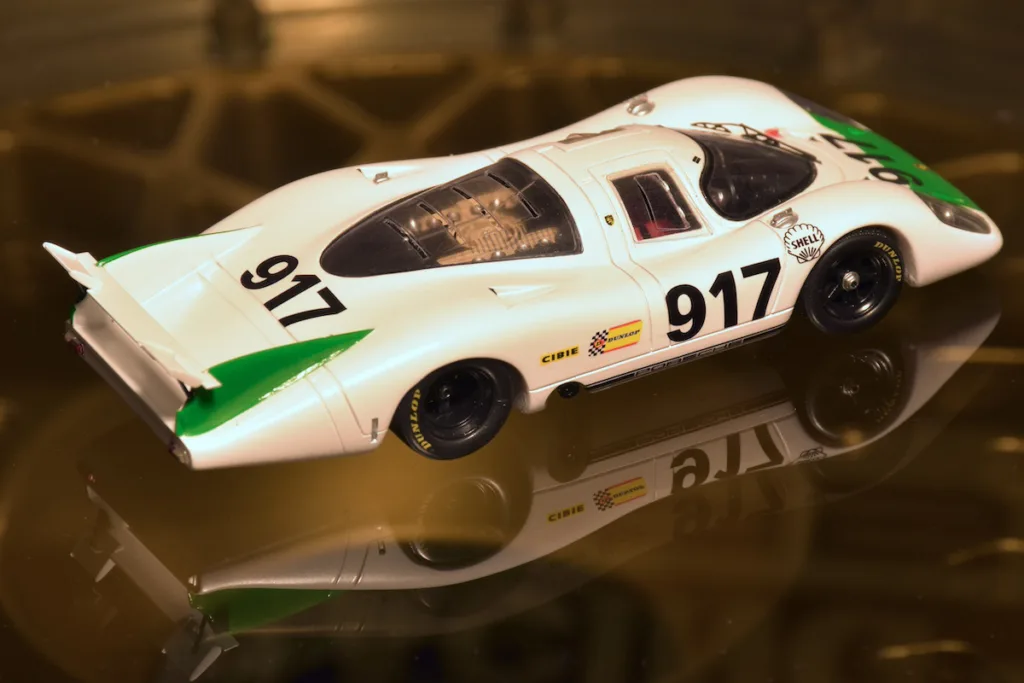
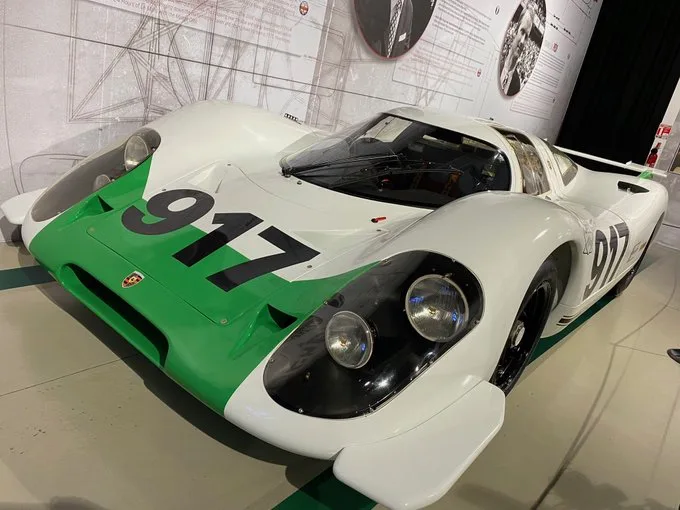
- SPARK AutoHebdo “40 years Porsche 917” #199 / 333 pcs (resin)
1969 Zeltweg 1000 km, Porsche 917. The first 917s were difficult to drive, especially the short one. ,But it managed to win its first race at Zeltweg, during the last event in the world championship. Days after this race John Wyer tested at Zeltweg a new body shape designed by mechanic John Horsmann. This new short tail gave the 917 much needed stability and improved laptimes by 4 seconds. This would be the 1970 917K, K stands for Kurzheck = shorttail.
#29 Jo Siffert (CH) / Kurt Ahrens Jr. (D) – 1st
Porsche 917 – 4.5 liter Porsche 912.00 – V12 180º, approx 570 hp. Dunlop tires. Weight 810 kg. Aluminum space frame, chassisnr. 917 #009
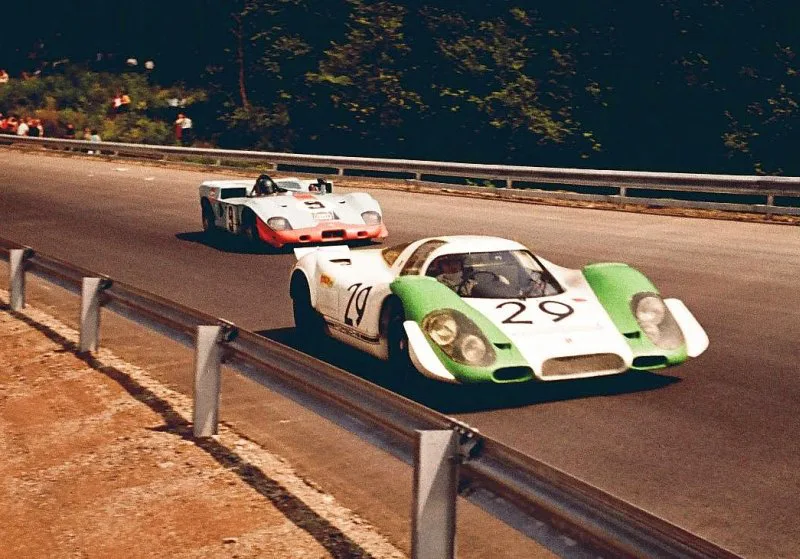
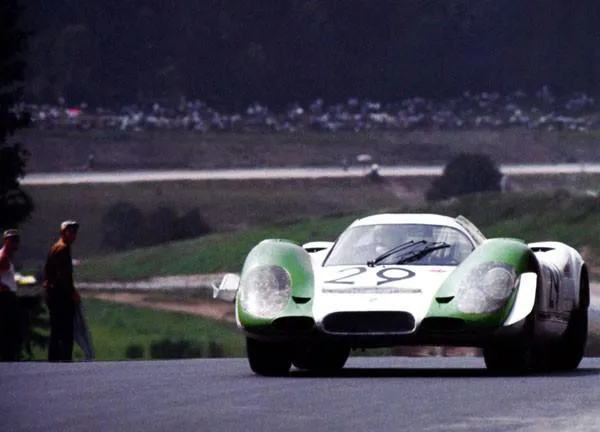
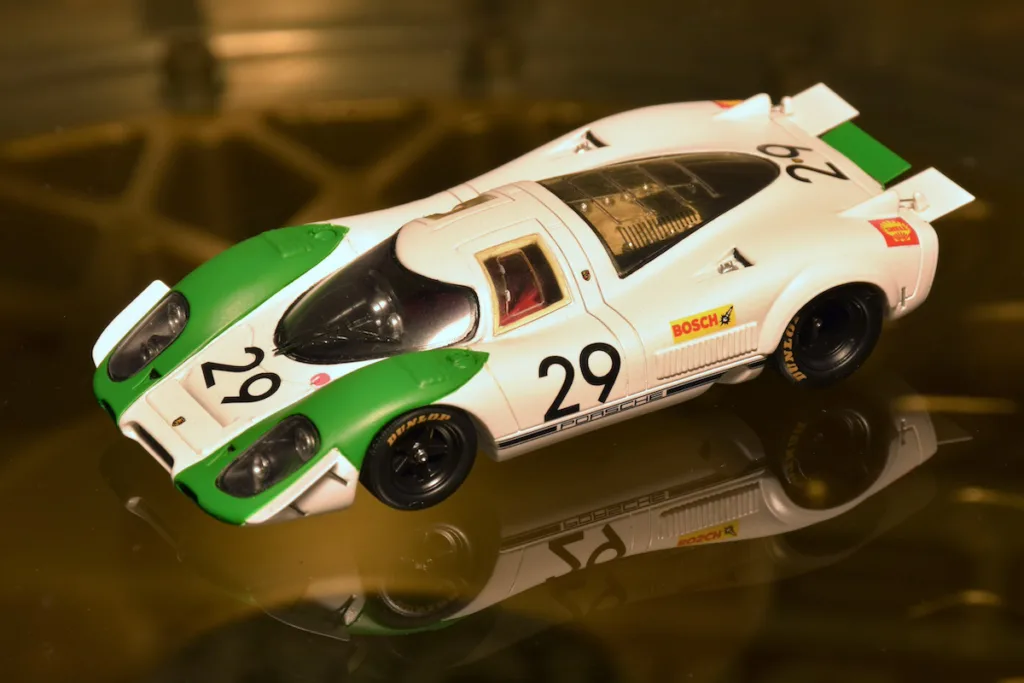
- SPARK S1897 (resin)
1969 Le Mans 24h, Porsche 917L. The Porsche 917 was produced in a small series to be able to compete with a larger engine than 3 liter. The first 917’s were blistering fast but difficult to drive. Privateer Woolfe got killed and the factorycars retired and the #15 was only used in practice. But the German cars would be back to win the next few years.
#12 Vic Elford (GB) / Richard Attwood (GB) – DNF
#14 Rolf Stommelen (D) / Kurt Ahrens jr. (D) – DNF
#15 Vic Elford (GB) / Herbert Linge (D) – DNS
Porsche 917L – 4.5 liter Porsche 912.00 – V12 180º, approx 570 hp. Dunlop tires. Weight 810 kg. Aluminum space frame, chassisnr. 917 #008, #007 & #006
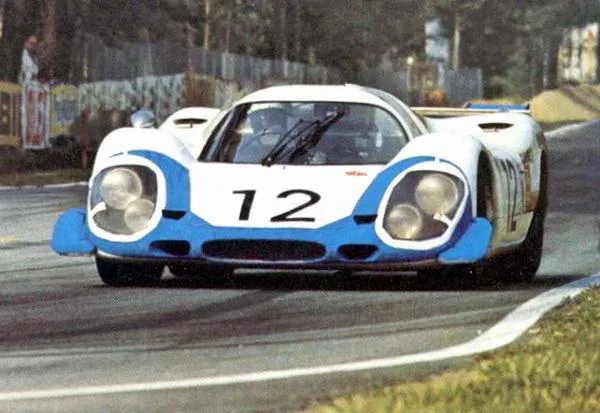
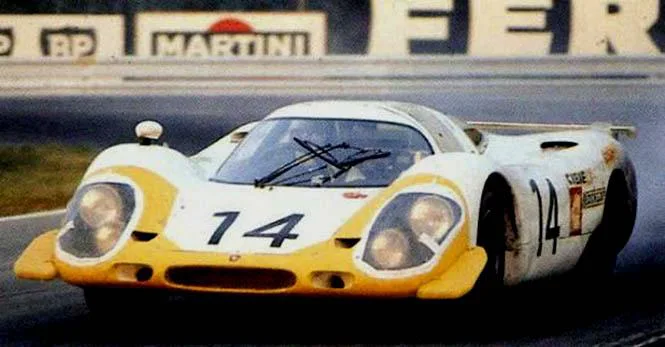
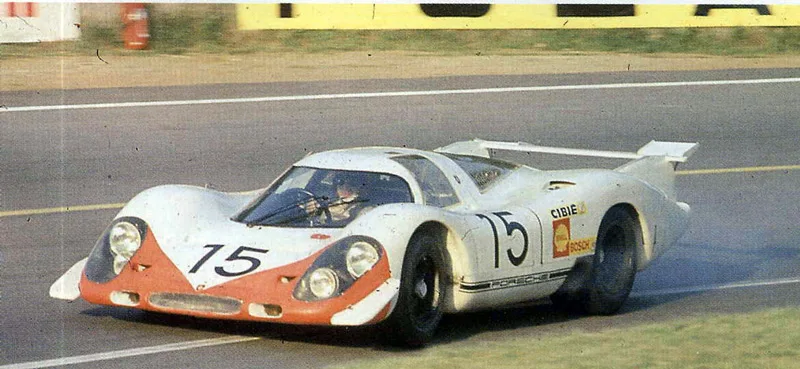
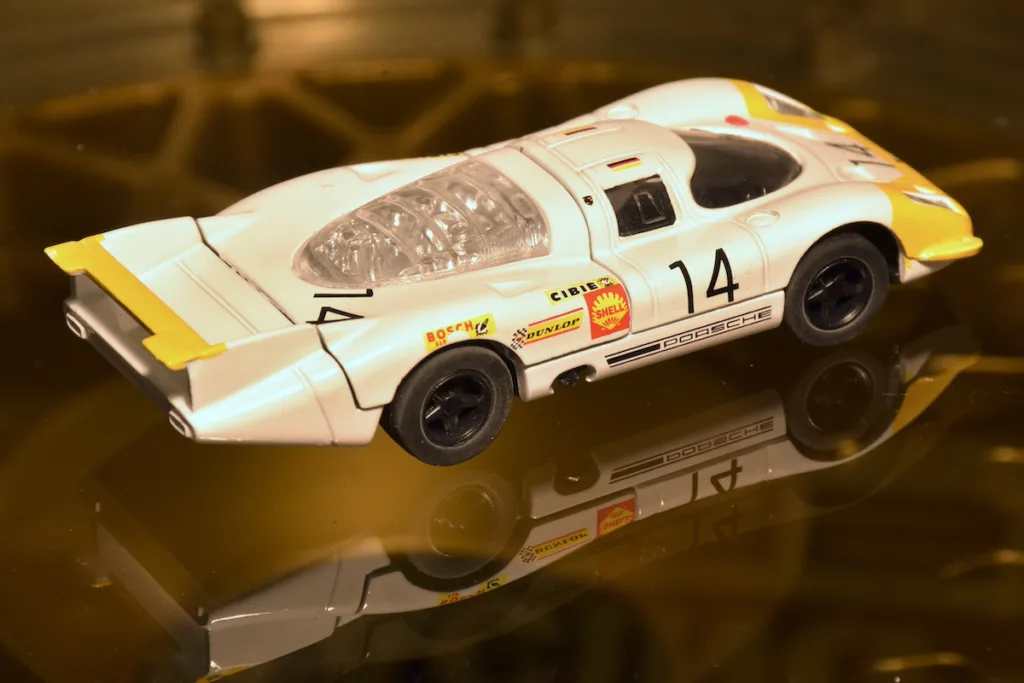
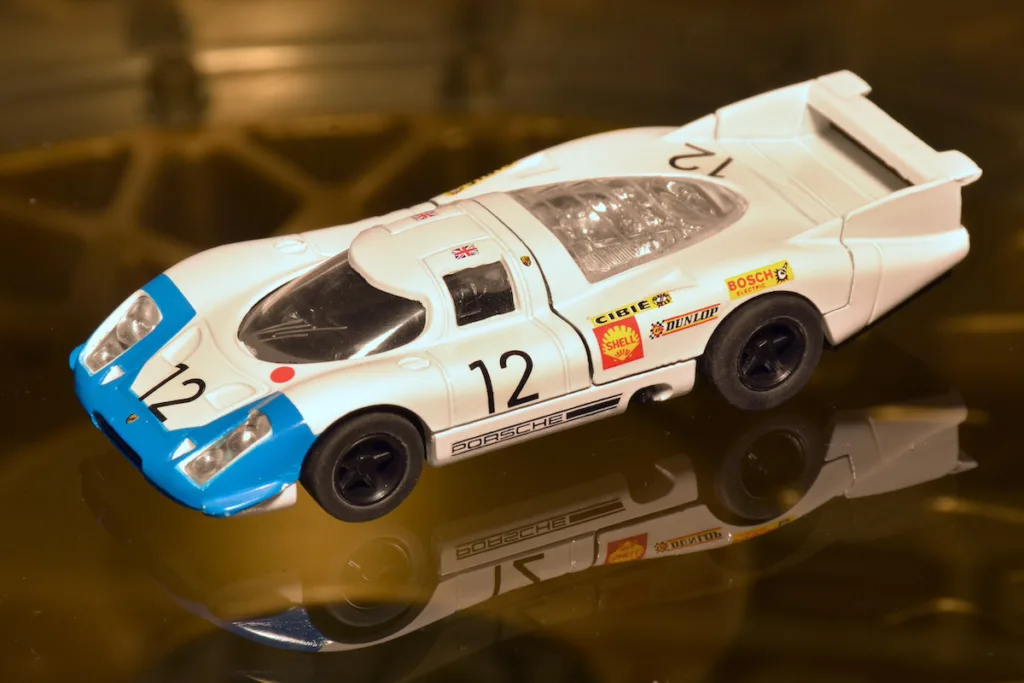
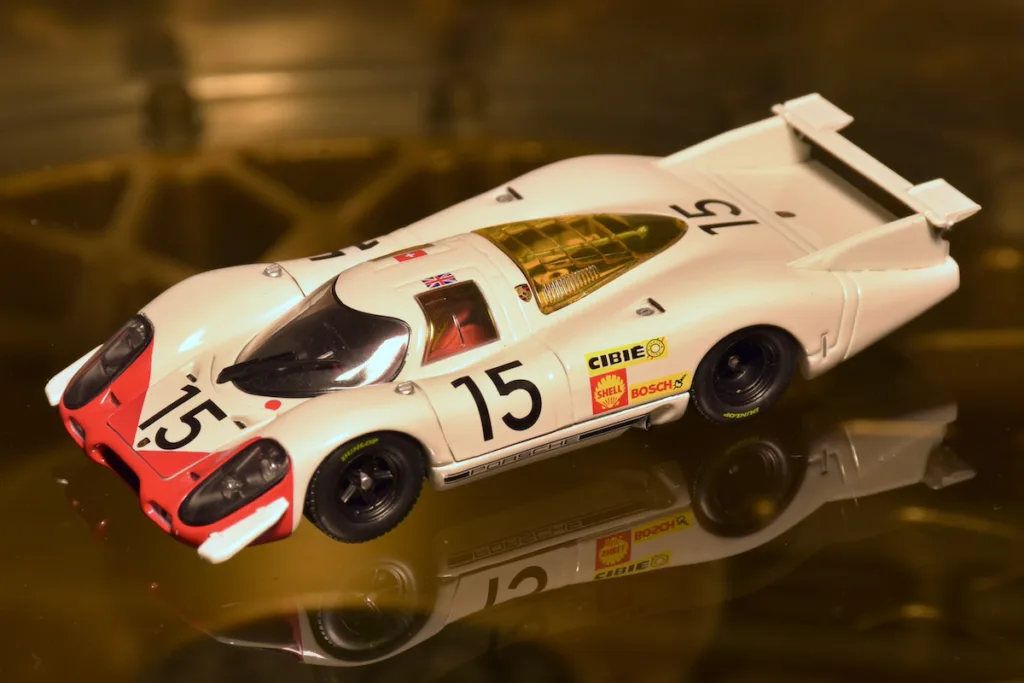
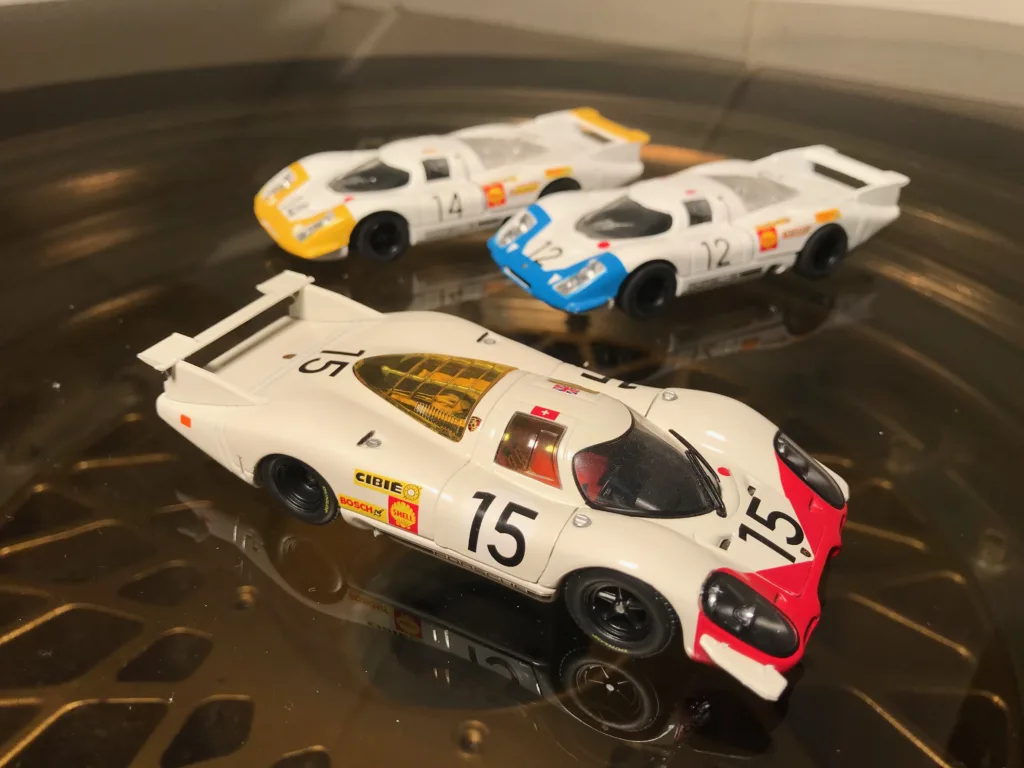
- ELIGOR 1198 & 1199 (diecast)
- EBBRO 43751 (diecast)
At the end of the year, the teams of John Wyer and Porsche Salzburg took over the racing activities from Porsche System Engineering.
Thanks for visiting 😉
